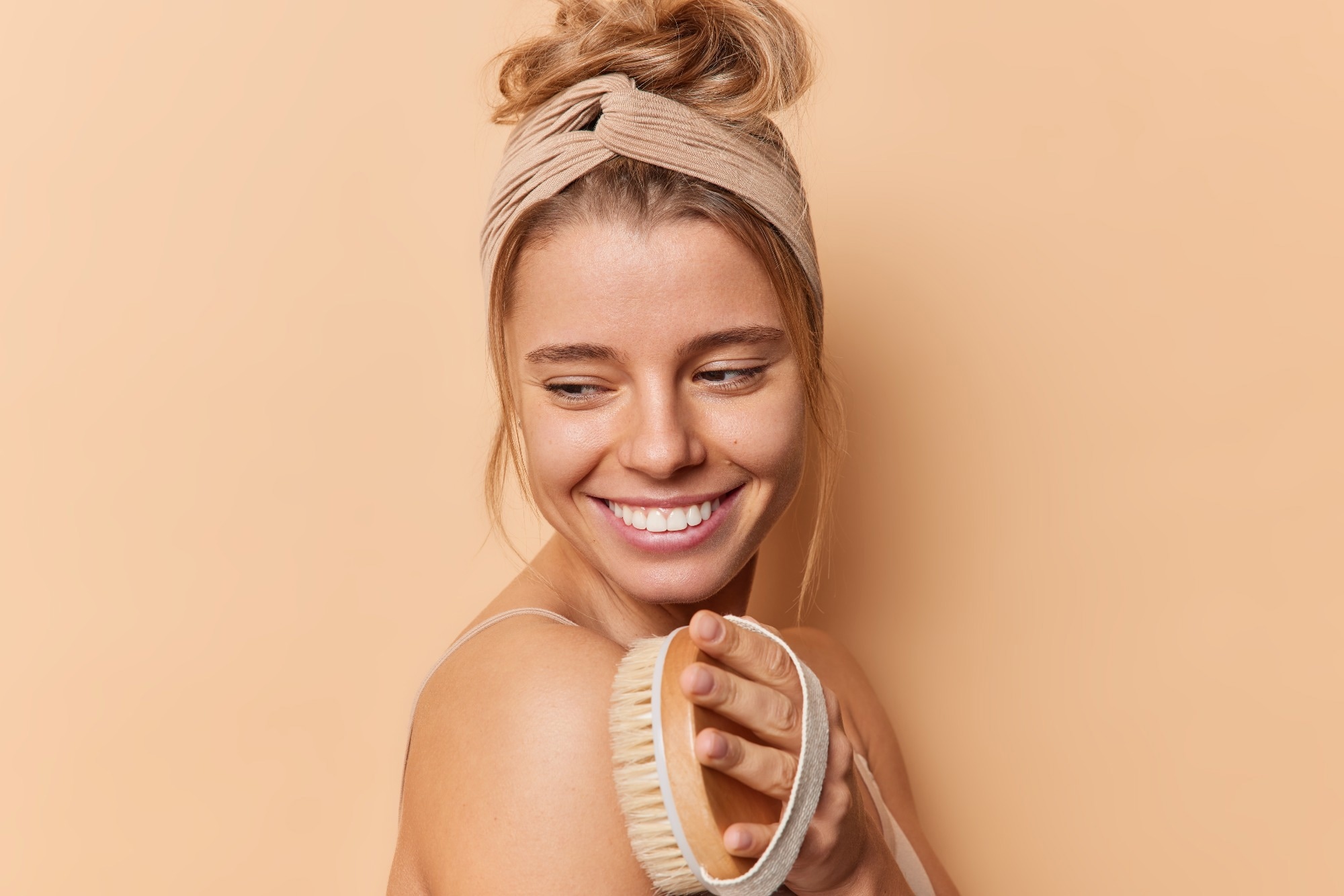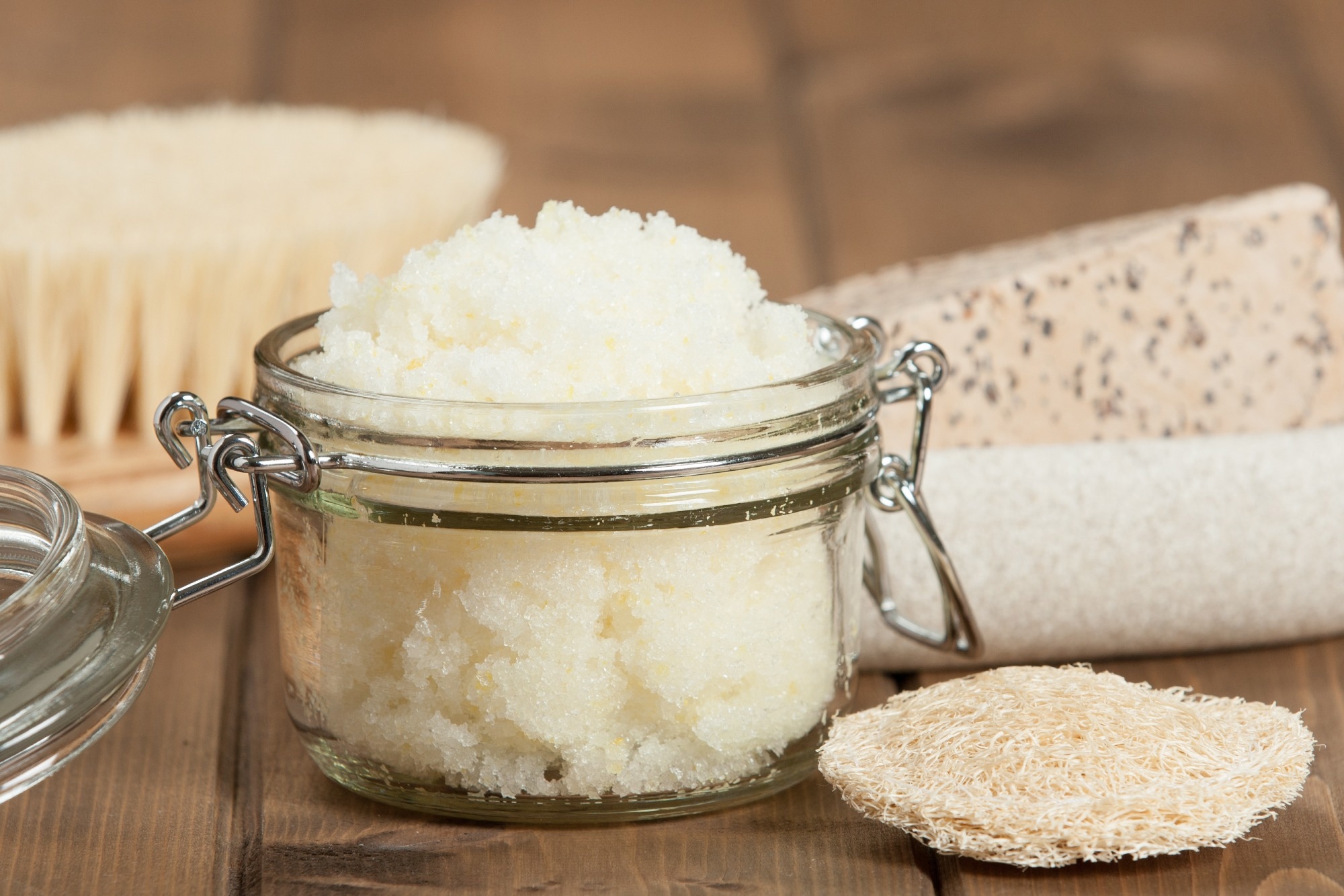Introduction
How dry brushing works: Tools, technique, and timing
What are the benefits?
Dermatologists weigh in: Potential benefits and risks
Lymphatic and circulatory claims
Comparison with other exfoliation methods
Evidence review
Is dry brushing safe?
A low-risk ritual with modest results
References
Further reading
Discover what science really says about dry brushing, how it stacks up against other exfoliation methods, and what dermatologists want you to know before adding this trendy ritual to your routine.
 Image Credit: Cast of Thousands / Shutterstock.com
Image Credit: Cast of Thousands / Shutterstock.com
Introduction
Dry brushing is a form of mechanical exfoliation that involves using a stiff, natural-fiber brush on unmoistened skin to detach corneocytes, thereby improving circulation and lymphatic flow. Dry brushing has been widely popularized through social media tutorials, dermatology clinics, and spa menus, which reflects growing consumer interest in low-cost, at-home skincare rituals.
Scientific literature offers sparse and often heterogeneous evidence on the potential health benefits associated with dry brushing. Thus, additional studies are needed to determine how dry brushing compares with chemical and physical exfoliants such as alpha-hydroxy acids (AHA), retinoids, and microdermabrasion.1,2
How dry brushing works: Tools, technique, and timing
Dry brushing is performed on completely dry skin using a stiff, natural-fiber brush. Starting at the feet or hands, each firm and sweeping stroke travels toward the nearest lymphatic basin like the groin, armpits, or heart, eventually progressing distal-to-proximal to allow for the superficial return of lymph and venous flow.
While dry brushing, users are advised to work in small sections, overlapping strokes five to ten times, until the skin shows a light flush but never breaks. Only light pressure should be applied over thin or sensitive areas, skin wounds, varicosities, or inflamed patches.3
Brushes are typically palm-sized with cactus, sisal, or jute bristles for limbs and torso, whereas a long-handled dry brush can be used to access hard-to-reach areas on the back. Some traditions substitute corncobs, raw-silk gloves, or fruit-fiber pads, which illustrates that texture, rather than the shape, is the critical variable in this practice.3
A dry brushing session can typically be completed in three to five minutes, with optimal results achieved immediately before showering to wash away loosened corneocytes. Hot water and soap can briefly dehydrate skin; therefore, dry brush practitioners should apply a bland emollient afterward to restore the lipid barrier.3
In addition to mechanical exfoliation, the rhythmic distal-to-central friction resembles manual lymphatic drainage and kanpumasatsu. Both modalities have been shown to enhance superficial circulation and support lymphatic flow.3
How to Dry Brush | goop
What are the benefits?
The stiff natural bristles of dry brushes remove dull corneocytes, which immediately reveals smoother skin. Rhythmic dry brushing strokes also encourage capillary microcirculation and lymphatic return, thereby redistributing interstitial fluid to reduce the dimpled appearance of cellulite.
Dry brushing may also support detoxification by encouraging lymph flow that carries metabolic waste to filtration nodes. Tactile stimulation and quickened blood flow combine to create an energizing and mood-lifting sensation that resembles a light massage.4
Dermatologists weigh in: Potential benefits and risks
Dry brushing provides a purely mechanical form of exfoliation, as firm strokes dislodge corneocytes from the stratum corneum, revealing newer, smoother epidermal layers. Spa and self-care literature credit this light abrasion with improved micro-circulation and lymphatic flow, which may further refine surface texture.
Nevertheless, dermatologists warn that the potential benefits of dry brushing are limited. Bristles that are too stiff, strokes that last too long, or dry brushing on hydrated skin can strip intercellular lipids, weaken the moisture barrier, and leave microscopic fissures that sting or burn when water, cleansers, or actives are applied. As a result, practitioners advise limiting dry brushing to once or twice weekly, choosing natural-fiber brushes, and stopping as soon as mild erythema appears.
Individuals with eczema, acne, or neuropathic sensitivity should avoid dry brushing altogether, as compromised skin increases the risk of irritation and may exacerbate underlying inflammation and delay recovery.3,5
Lymphatic and circulatory claims
Lymph fluid only moves when lymphatic muscle cells contract rhythmically or in response to external forces, such as walking, which applies pressure to lymph vessels. To date, controlled skin-rubbing studies on dry brushing have reported only transient increases in temperature, pulse, and blood gases that never reach statistical significance and subside within minutes, while immune markers and C-reactive protein remain unchanged. Consequently, no clinical data have confirmed that dry brushing significantly accelerates lymph clearance or blood flow.3,6
Comparison with other exfoliation methods
Chemical exfoliation with AHAs and beta-hydroxy acids (BHAs) disrupts intercellular adhesion between corneocytes, thereby allowing for the controlled removal of dull surface layers and, at higher concentrations, penetration to deeper viable epidermis. Several studies have confirmed the efficacy of these acids in treating acne, melasma, photoaging, and texture irregularities.
Enzymatic exfoliants like papain and bromelain rely on proteolysis, rather than abrasion, with this keratolytic activity unable to penetrate the stratum corneum. As a result, enzymatic exfoliants are considered a safer option for individuals with reactive or barrier-impaired skin.2,7
 Image Credit: EasterBunny / Shutterstock.com
Image Credit: EasterBunny / Shutterstock.com
Microdermabrasion propels micro-crystals across the skin to plane the stratum corneum and induce collagen remodeling. This form of exfoliation is more intense than traditional scrubs. It has been shown to significantly reduce the appearance of scars and photodamage when precise technique and after-care are observed.
Classic wet physical methods, such as granular scrubs, loofahs, and cleansing brushes, produce similar mechanical effects. Through these approaches, water and lubricants reduce friction, which produces micro-trauma that is milder than that caused by dry brushing.
Dry brushing abrades unmoistened skin, is an inexpensive and easy-to-perform technique; however, it is the least studied modality and can provoke irritation or barrier disruption if used aggressively. Although all exfoliation strategies lift dead cells, their depth of action, evidence base, and safety margins vary. Chemical peels and microdermabrasion offer the most documented and controlled results, whereas dry brushing is considered the most superficial method with unclear efficacy.2,7
Evidence review
Most advertised benefits of dry brushing, such as enhanced lymph flow, cellulite smoothing, detoxification, or energy boosts, have been based on magazine and spa marketing, rather than controlled trials. Dermatological literature accepts that brisk brushing mechanically removes corneocytes, thereby improving texture; however, systemic toxin clearance is considered biologically implausible and unproven.
Consequently, current evidence supports dry brushing as a superficial exfoliant. Accurate, randomized studies are needed before broader recommendations can be justified.2,3,7
Is dry brushing safe?
Dry brushing should be practiced cautiously, with all users advised to remain attentive to any skin reactions. Dry brushing should not be applied to inflamed, broken, sunburned, or unusually sensitive areas to avoid worsening irritation.
Between uses, the brush should be washed with mild soap and allowed to air-dry thoroughly to prevent bacterial or fungal growth. After brushing, a moisturizer rich in ceramides or plant oils should be applied to restore protective lipids and lock in hydration.
Dry brushing should be limited to between one and three times every week. If redness, tightness, or stinging occurs, the frequency of dry brushing should be reduced until the skin has healed.1,3
A low-risk ritual with modest results
Dermatologists classify dry brushing as a low-intensity, cosmetic exfoliation ritual, rather than a therapeutic intervention. Consumers should dry brush judiciously, monitor their skin response, and consult established medical care for any clinical concerns.
References
- Loughran, J. (2002). Natural Skin Care. B. Jain Publishers.
- Almeman, A. A. (2024). Evaluating the efficacy and safety of alpha-hydroxy acids in dermatological practice: a comprehensive clinical and legal review. Clinical, Cosmetic and Investigational Dermatology, 1661-1685. DOI: 10.2147/CCID.S453243, https://www.dovepress.com/evaluating-the-efficacy-and-safety-of-alpha-hydroxy-acids-in-dermatolo-peer-reviewed-fulltext-article-CCID
- Komagata, S. (2023). Kanpumasatsu: A superficial self-massage with a dry towel to enhance relaxation and immune functions. Journal of Interprofessional Education & Practice, 31, 100609. DOI: 10.1016/j.xjep.2023.100609, https://www.sciencedirect.com/science/article/abs/pii/S2405452623000113?via%3Dihub
- Seo, H. (2022). Dry Brushing, Body Scraping, Gua Sha: Lymphatic Health Is All the Rage. International New York Times, https://trilliumchinesemedicine.com/wp-content/uploads/2022/09/lymphatic-drainage-does-it-work-and-how-to-do-it-yourself-the-new-york-times.pdf
- Samuelsson, M., Leffler, A. S., Johansson, B., & Hansson, P. (2009). 247 THE INFLUENCE OF BRUSHING FORCE AND STROKING VELOCITY ON DYNAMIC MECHANICAL ALLODYNIA IN PATIENTS WITH PERIPHERAL NEUROPATHY. European Journal of Pain, 13(S1), S78b-S79. DOI: 10.1016/j.ejpain.2010.09.004, https://onlinelibrary.wiley.com/doi/10.1016/j.ejpain.2010.09.004
- Scallan, J. P., Zawieja, S. D., Castorena‐Gonzalez, J. A., & Davis, M. J. (2016). Lymphatic pumping: mechanics, mechanisms, and malfunction. The Journal of physiology, 594(20), 5749-5768, DOI: 10.1113/JP272088, https://physoc.onlinelibrary.wiley.com/doi/10.1113/JP272088
- Karwal, K., & Mukovozov, I. (2023). Topical AHA in dermatology: Formulations, mechanisms of action, efficacy, and future perspectives. Cosmetics, 10(5), 131. DOI: 10.3390/cosmetics10050131, https://www.mdpi.com/2079-9284/10/5/131
Further Reading
Last Updated: Jul 10, 2025